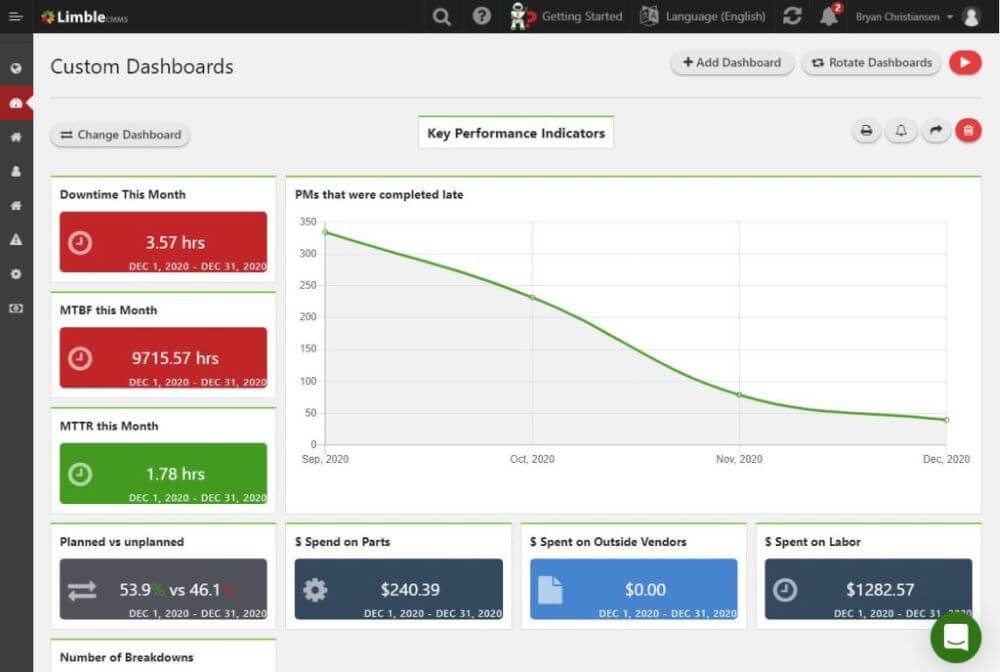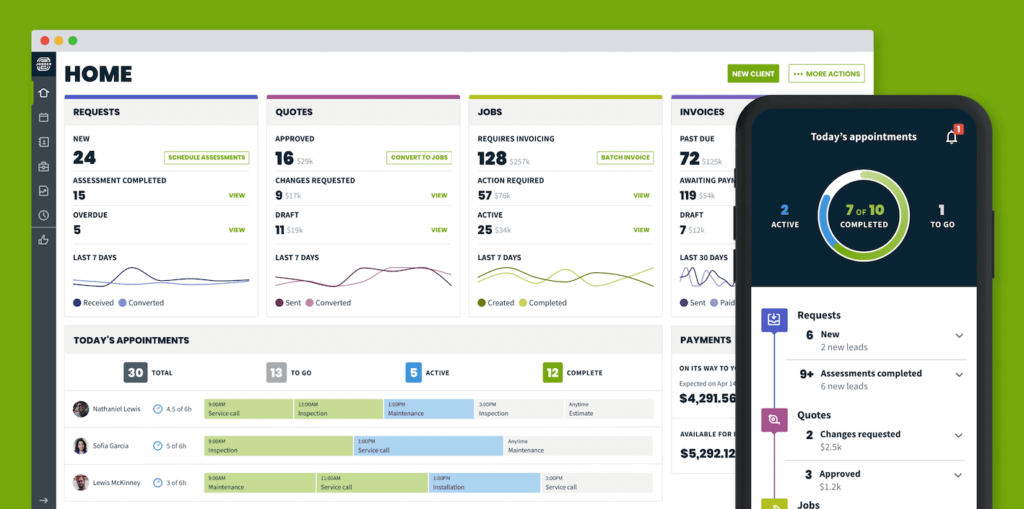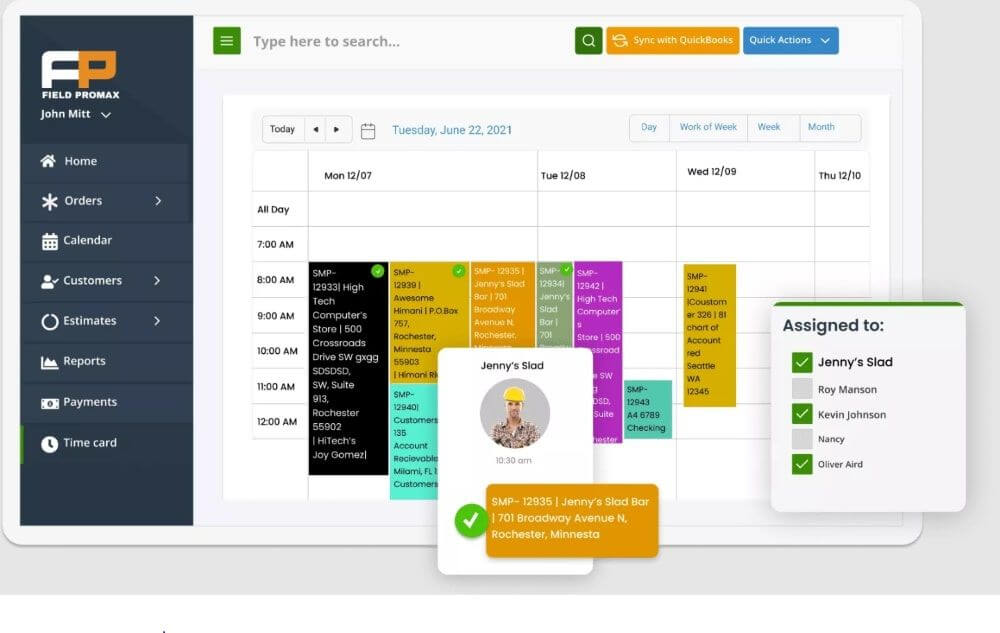Work orders can be a lot of… work.
You constantly need to create, dispatch, and verify work orders to keep your business moving. Between these three steps, you end up dedicating your whole day to this single part of your business. This is why it’s important to have a work order management system in place.
Work order management improves your work orders, but it also strengthens your bottom line. In this article, you’ll learn how that’s possible and discover the best work order management systems to enhance your business.
What is a work order?
A work order is a document that lays out the required information to complete a job. Although the definition is simple, work orders play an important role in field service management.
For field service businesses, the sales process usually looks like this:
- You present an estimate to your customer.
- Once the estimate is approved, you create a work order to dispatch the job.
- Upon completion of the job, you deliver an invoice to your customer.
As you can see, work orders are the glue that holds this process together, making them a key part of field service management. Without them, the right people wouldn’t have the information they need to get the job done.
By the way, did you notice how connected the three steps are? If you have an efficient work order management system, these steps blend into one seamless process.
We’ll explore this more later, but first, you need to know what exactly a work order management system is.
What is a work order management system?
In simple terms, work order management involves the creation and processing of work orders. However, the process isn’t always simple.
Without the proper tools, work orders can be tedious to create. If you run a successful service business, chances are that you create several work orders a day. That’s potentially hours of work spent on one task.
What’s more is that you need a way to process your work orders to ensure that they get to the right people at the right time. When you spend too long creating a work order, you risk throwing off your workflow. And worse, making errors that lose you customers.
This is why it’s important to have a work order management system, and the best way to implement a system is with software.
Work order software streamlines your work order process and enhances your overall business operations. Let’s find out how.
The benefits of work order software
There are multiple reasons you should use work order software for your business, and it’s not just to make creating your work orders easier. Work order software improves all aspects of your business.
Your work order system is an element in the bigger system that is your business. Your different systems work together, causing your business to operate smoothly.
For example, your work order system affects your scheduling system since the reliability of your schedule depends on how efficiently you process work orders.
If your technician depends on you to send them a work order, and there’s a delay on your end, suddenly they’re behind schedule. The result can be destructive for your business as it leads to:
- Missed jobs.
- Unhappy customers.
- Revenue loss.
A good work order management system prevents delays, and the right work order software makes that happen.
Here are some other benefits of work order software.
Goodbye manual work, hello automation
Accurate paperwork is important for any business, but entering data into a spreadsheet does not generate revenue. Manual data entry is:
- Tedious.
- Time-consuming.
- Error-prone.
Work order management software provides a better way. Speed up the process with work order templates. Customize these templates by choosing the work order format that works for your business, and fill them in within minutes.
What’s more is that some software solutions allow you to automate recurring work orders to ensure that your loyal customers always get the excellent customer service you’re known for.
This means you spend less time doing paperwork and more time building relationships with your favorite customers.
Get your priorities straight
Creating work orders is only the first step in the process. The hard part is managing them. This requires you to prioritize requests based on:
- The type of work.
- Urgency.
- Specific customer requests.
Work order software makes it easy to keep track of your work orders. Better yet, service order tracking software keeps you up to date with every job status.
The best work order management software enables direct communication between your office team and field crew, ensuring nothing slips through the cracks.
Empower your team
Automation and clear prioritization are a recipe for a highly efficient business. A good work order management system motivates your team by boosting productivity.
Think about it: the sooner your field technician gets a work order, the sooner they can start the job. If your tech is constantly waiting around between jobs, that’s both time and money wasted. The same goes for last-minute changes.
As a field services business owner, you know that last-minute service requests are a part of the job.
But when you receive a cancellation while your field tech is already on the way to the job, it’s crucial that you get this information to them immediately.
Streamlining your work order process allows information to travel quicker, eliminating downtime between jobs. For even better efficiency, use a mobile app to provide your techs with real-time updates.
Are you convinced that a work order management system is what your business needs? Here’s how to choose the best one.
How to choose your work order management system
Most work order management software has a few common elements, including:
- Work order creation.
- Work order tracking.
- Basic reporting.
However, to make the most out of your work order system, you should choose a solution with additional features that enhance your overall business operations.
Before choosing a work order system, start by stepping back and taking a look at your business. Ask yourself these questions:
- Which part of your work order management needs improving?
- Do you want your work order process to integrate with your other workflows?
- What other tools do you use for work orders?
The way you answer these questions determines the best work order management system for your business.
For example, if you use different software solutions for your day-to-day operations, finding a work order system that integrates with your existing technology is a must.
The best work order management systems
The best work order management software doesn’t just create work orders. Good field service management software:
- Gives you real-time insights.
- Has a mobile app.
- Integrates with your other tools.
To help you choose, here are the best work order management systems for field service businesses.
1. Method:Field Services
First on our list is Method:Field Services—the best work order management solution for QuickBooks users.
QuickBooks is a tool that many businesses rely on for their daily operations. So it’s disappointing to hear that QuickBooks doesn’t offer a work order form. However, Method:Field Services bridges this gap.
Method’s two-way sync pulls customer and job details from QuickBooks into a work order, without disrupting your workflow. But that’s just the beginning.
From there, you can customize your work order to suit your needs. Add photos, custom fields, and more with Method’s drag-and-drop system.
Remember when we mentioned that estimates, work orders, and invoices can be combined into one process? Method makes that happen.
With a click of a button, turn your estimates into work orders, then your work orders into invoices that sync with QuickBooks. No more copy and paste or double data entry.
Use your work order information to generate customized reports, enabling you to make data-driven decisions to drive your business forward.
Here’s what else is possible with Method:Field Services:
- Employee time-tracking that syncs with QuickBooks.
- Capture e-signatures on site.
- Instantly receive payments through an online portal.
- Receive real-time updates through the mobile app.
- Integrate with your everyday tools such as Outlook and Google Calendar.
Method:Field Services makes work order management easy and improves your entire sales process.
2. Limble CMMS

The next field service solution on our list of best work order management systems is Limble CMMS.
Limble lets you quickly organize your work orders and other tasks. Plus, you can manage them from any device.
With Limble, you can:
- Assign jobs to individuals or teams.
- Receive email notifications with work order updates.
- Leave comments on work orders.
- Track time, including downtime.
One of Limble’s strengths is its asset management solution, which allows you to organize and secure your business’ asset data.
Limble’s main drawback is its inability to convert work orders into invoices, requiring you to manually create an invoice once the job is completed.
3. Jobber

Jobber lets you keep track of all aspects of active jobs, including time spent on work orders.
This software solution has many of the capabilities needed for optimal work order management, including:
- Recurring scheduling.
- Custom line items.
- Ability to add photos and additional notes.
What’s more is that you can create a new job on the spot, or turn a work request into a work order from your desktop or Jobber’s mobile app. Rescheduling and reassigning jobs is just as easy, and you can notify your team instantly.
It’s important to note that if you want a full calendar view of your jobs, you’ll need to sync Jobber to Google Calendar, as this software solution doesn’t have this feature on its own.
4. Field ProMax

Last on our list of the best work order management systems is Field ProMax.
Field ProMax is another field service solution that integrates with QuickBooks and converts work orders into invoices.
When it comes to work order management, Field ProMax’s strengths lie in its ability to integrate time cards with work orders, creating a more reliable payroll.
Once the job is complete, your techs submit their time cards for approval through the app and can view, but not edit their entries until payday.
Field ProMax simplifies other work order related tasks, such as:
- Assigning team leads.
- Visualized scheduling.
- Multiple calendar views.
Although Field ProMax is great for creating work orders, it lacks additional features that enhance work order management, such as customizable reporting.
Recap: How to improve your work order management
Whether your business specializes in preventative maintenance or repairs, work orders are the way you get things done.
A good work order management system benefits your business in several ways. To make the most of a work order system, look for software that:
- Creates recurring work orders.
- Enables work order tracking.
- Provides real-time updates on job progress.
- Converts work orders into invoices.
Ready to improve your work order management? Start your Method:Field Services free trial today!
Image credit: Le Minh via Pexels






